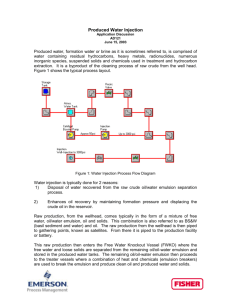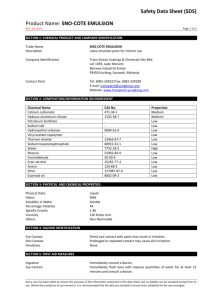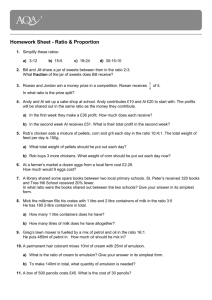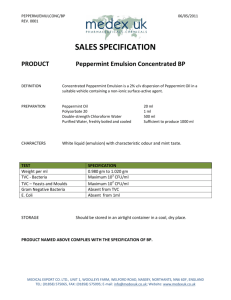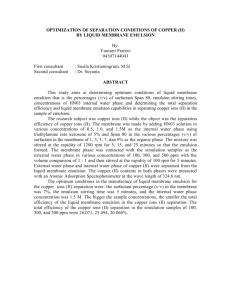Typical Natural Gas Components
advertisement
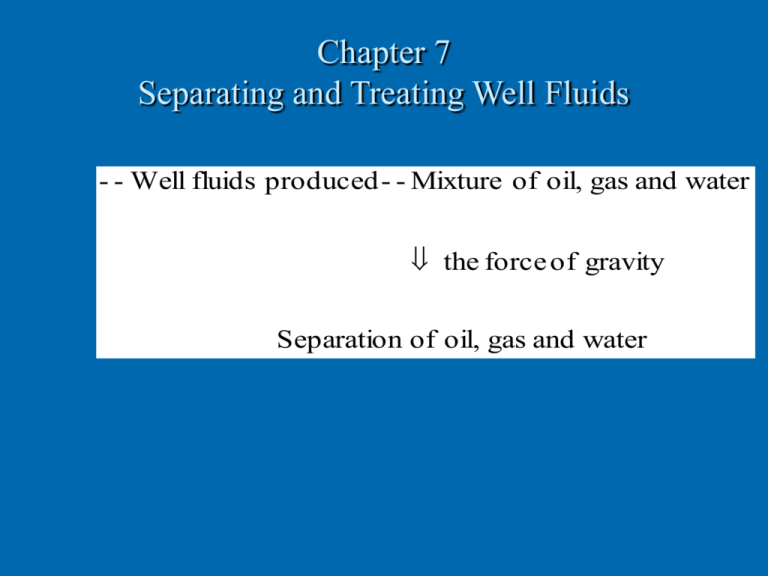
Chapter 7 Separating and Treating Well Fluids - - Well fluids produced - - Mixture of oil, gas and water the force of gravity Separation of oil, gas and water Principles and Operation of Production Separators ─ Gas, oil and water separation was achieved by the difference in gravity, or weight, of each fluid. ─ Production separators do the same job, except they are built to handle a continuous-flow stream and have features to improve separation efficiency under flow conditions. 2 3 Three general types of separators ─ Horizontal separator ─ for high-pressure and medium-pressure service ─ Vertical separator ─ for low-pressure service (generally) ─ Spherical separator ─ more compact and cheaper ─ limited separation space and liquid surge capacity ─ for low-volume remote platforms 4 Internal Structure of Separators 5 6 Separation methods ─ Stage separation method ─ Low-temperature separation method 7 Stage separation method (two stage separation) Any number of separators may be used in stage separation as long as stage operates at successively lower pressures. 8 Low-temperatures separation method It is used to handle the production from high-pressure gas wells Well fluids – a mixture of gas & some light liquids Dehydration – the removal of water vapor from gas 9 Low – temperature separation method uses the cooling effect of expanding high – pressure gas 10 Low-temperature separation method For high-pressure gas wells (well fluids: mixture of gas and some light liquids) ─ Dehydration to remove water vapor from gas 11 Water-removal Water-removal — before the oil can be delivered to the pipeline Free water – some of the water produced with the oil will not be mixed with it ; this is known as free water . 12 Water removal ─Treatment of free-water using Free water knock out (FWKO) 13 Treatment of oil-water or water-oil emulsion Water and oil are immiscible. These two liquids will form an emulsion only (1) if there is sufficient agitation to disperse one liquid as droplets in the other , and (2) if there is an emulsifying agent , or emulsifier , present. Emulsifying agents – asphalt 瀝青 柏油 resinous substances oil-soluble organic acids. 14 Emulsions Emulsion – a mixture in which one liquid, termed the dispersed phase, is uniformly distributed (usually as minute globules, in another liquid, called the continuous phase or the dispersion medium (phase)) Oil – water emulsion – the oil is the dispersed phase, and the water (is ) the dispersion medium (or continuous phase ) Water-oil emulsion – the water is the dispersed phase, and the oil the dispersion medium 15 Emulsions -- continue Stable emulsion – will not break down into its components without some form of treating. Tight (difficult to break) or loose (easy to break) emulsion Depending on – (1) the properties of the oil & water (2) the percentage of each found in the emulsion (3) type and amount of emulsifier present . 16 Treatment of oil-water or water-oil emulsion Treatment of oil-water or water-oil emulsion (1)Heat (2)Chemicals (3)Electricity (4)Combination of these (heater- treater) flow treater or emulsion treated (5)Gun barrel or wash tank if emulsion is not stable 17 Application of heat One theory assumes that very small droplets, like those found in emulsions, are in constant motion even when the emulsion itself is not rest . Application of heat (1) Heat increases the movement are makes the droplets strike each other with greater force and frequency. (2) Heat also reduces the viscosity – the resistance to flow – of the oil. Heater (加熱器) (1) direct heater (2) Indirect heater—water bath (fig5.22 P.161) 18 Application of chemicals One theory suggests that chemical should be used strictly to neutralize the emulsifying agent. Thus, to break a water-in-oil emulsion, another emulsifying agent to produce oil-in-water emulsion should be added. Another theory suggests the chemicals should make the film of emulsifying agent around the water droplet in a water-in-oil emulsion very rigid. Thus, to break rigid film apply heat or add chemical. 19 Heater-treater Heater-treater also called a flow treater or an emulsion treater. Heater-treater (or call flow treater, or emulsion treater) apply the effects of Chemicals, heat , settling, and often electricity Any or all of the following elements may be included in a treater: • • • • • • • oil-gas separator, free-water knockout, heater, water, wash, filter section, stabilizing section, heat exchanger, and electrostatic field. 20 Treater Treater can be operated at atmospheric pressure, often be operated under low working pressure. A low-pressure, second-stage separator as well as treating unit. When flow-line pressure are low, it can be used as a primary separator thus eliminating the need for a regular separator. (fig 5.25, P.164) 21 Treating natural gas Field processing of natural gas consist of four basic processes: (1) the gas must be separated from free liquids such as crude oil, hydrocarbon condensate, water , and entrained solids, (2) the gas must be processed to remove condensable and recoverable H.C. vapors (3) the gas must be treated to remove condensable water vapor, which might cause hydrate formation (4) the gas must be treated to remove other undesirable components, such as hydrogen sulfide or carbon dioxide. 22 Treating Natural Gas The primary treatments for natural gas involve (1)prevention of hydrate formation by applying heat and/or adding hydrate inhibitor: ammonia brine glycol (乙二醇) methanol (甲醇) (2)dehydration, absorption (吸收) – Liquid 乾燥劑 adsorption (吸附) – Solid 乾燥劑 (3)The removal of undesirable components (H2S、CO2) Alkanolamine process Iron-sponge process Glycol/amine process Sulfinol process Molecular-sieve removal 23 Prevention of hydrate formation Water is always necessary for hydrate formation. water always accelerates corrosion. 24 25 Phase diagram for a pure single component 26 Dehydration means removal of water Water vapors (as well as certain other vapor) are removes from gas by either (1) the absorption process, or (2) the adsorption process Absorption process -Water vapor may be removed from natural gas by bubbling the gas counter currently through certain liquids that have a special attraction or affinity for water. 27 Dehydration means removal of water Adsorption -Some solids also have an affinity for water, and when gas flows through a bed of such granular solids, the water is retained on the surface of the particles. Desiccant -The liquid or the solids that has the affinity for water in either process is called a desiccant. Dehydration equipment -- The liquid-desiccant dehydrator -- The solid-desiccant dehydrator 28 Removal of undesirable components Hydrogen sulfide (H 2S) acid gases Carbon dioxide (CO 2 ) Alkanolamine process -- It is a continuous-operation liquid process that uses absorption for the acid-gas removal, with subsequent heat addition to string the acid-gas component from absorbent solution. Other processes that are used to removal H2S & CO2 are The Iron-sponge process, The glycol/amine process, The sulfinol process, and The molecular-sieve removal. 29 Typical Natural Gas Components 30 Casinghead gas -- gas produced with oil from an oil well. Residue gas -- any gas suitable for as commercial natural gas that comes from a processing plant. Sweet gas --the content of hydrogen sulfide, other sulfur compounds, and carbon dioxide is low enough that gas may be sold commercially without further effort to remove these compounds. Sour gas --the opposite of sweet gas. 31 Types of Natural Gas Liquids Commercial propane (丙烷) -- propane and/or propylene (at least 95%) -- vapor pressure < 215 psig at 100 0F Commercial Butane (丁烷) -- butanes and/or Butane (at least 95%) -- vapor pressure < 70 psig at 100 0F -- At least 95% must evaporate at 34 0F or lower in a standard test. Liquefied Petroleum Gas (LPG) -- A mixture of commercial propane and commercial butane. -- maximum vapor pressure < 215 psig at 100 0F At least 95% must evaporate at 34 0F or lower in a standard test. 32 Types of Natural Gas Liquids Natural Gasoline --This petroleum product is extracted from natural gas --specifications: • Vapor pressure:10-34psi • Percentage evaporated at 140 F: 24-85% • Percentage evaporated at 275 F: not less then 90% 33 Vapor pressure, usually referred to as Reid vapor pressure (RVP), used to designate grades. Motor fuels: 5-8psi RVP Very light oils (60-70AIP): 12psi RVP Natural gasoline product: 14-26 psi RVP 34 The Storage System 35 The Storage System Stock tanks (or storage tanks) ─Tank battery ─separation equipment treating equipment storage facilities tank battery ─stock tanks Bolted steel tank – 500 bbls or larger; assembled on location Welded steel tank – 90 bbl to several thousand bbls; welded in a shop and then transported as a complete unit to the site ─Vapor Recovery System ─LACT (Lease automatic custody transfer) unit Oil sampling thief-sampling method bottle-sampling method Gas sampling 36 37 38 39 40 41 42 Treatment of emulsion Therefore, To break down a petroleum emulsion the properties of emulsifying agent must be neutralized or destroyed . By application of (1) heat (2) chemicals (3) electricity, or (4) combination of these (heater – treater ) 43 The well stream The well stream -- high-velocity, turbulent, constantly expanding mixture of gases and hydrocarbon liquids, intimately mixed with water vapor, free water solids and other containment. 44 The bottle test -- It is used to help determine which chemical can most effectively break the emulsion from a given well, lease, or field. Result from a bottle test also indicate the required ratios of treating compound to emulsion. That is, the smallest around of the proper chemical need to satisfactorily break the volume of emulsion being produced. Application of electric current Usually in conjunction with heat & chemicals. 45 Gun barrel or Wash tank Sometimes an oil-water emulsion is not stable, Given enough time, the water will settle to the bottom of a tank and oil will rise to the top. The settling vessel used for this kind of separation method is called a gun barrel or wash tank. 46 Stock tanks (storage tanks ) Once the oil is clean enough to meet pipeline specifications, it is flowed into storage tanks, sometimes called stock tanks. Tank battery- 47 Stock tanks (storage tanks ) Two basic types of stock tanks: bolted steel welded steel Bolted steel tanks - 500 bbl or larger; assembled on location. Welded steel tanks - 90 bbl to several thousand bbls. Welded in a shop and then transported as a complete unit to the site. Most tanks are equipped with a bottom drain out let for draining off basic sediment and water (BS&W). 48 Vapor Recovery System when oil is treated under pressure and then goes to a stock tank at pear atmospheric pressure, some of the liquid hydrocarbons flash, or convent, to gas. -- In past years, flash gas or vapor were vented to the atmosphere. -- Governmental agencies now insist on vapor recovery in order to reduce air pollution. A vapor recovery unit consists of * a control pilot mounted on a tank for compressor control, * a scrubber to keep the liquid hydrocarbons out of the compressor, * a compressor, and *a control panel. 49 Treating oil-field emulsions Emulsion 之定義 dispersion water phase continuous Oil - Water Emulsion (oil in water) oil - dispersed phase Water - oil Emulsion (water in oil) Oil and water to form an emulsion only (1) sufficient agitation asphalt 瀝青 (2) emulsifyin g agent or emulsifier exist resinous substances oil - soluble organic acid Tight difficult to break Emulsion Loose easy to break 50


